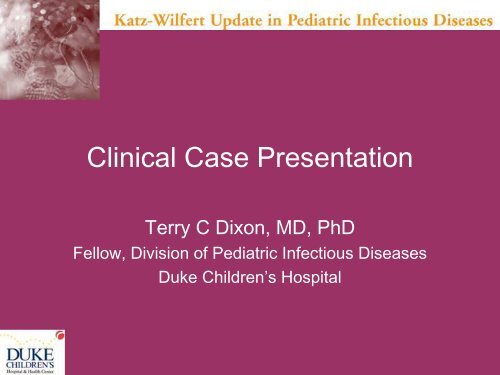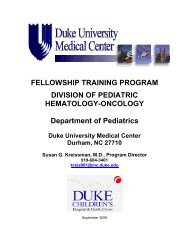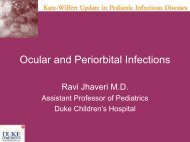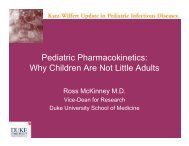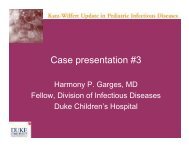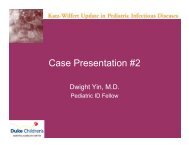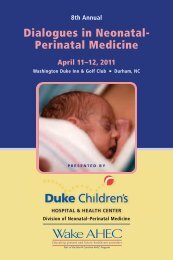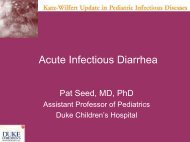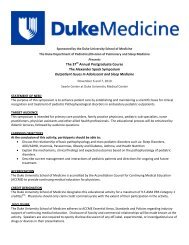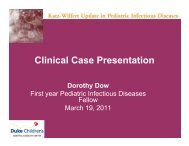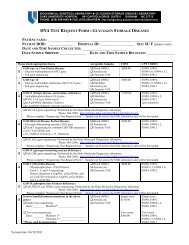Clinical Case Presentation - Duke Pediatrics Intranet
Clinical Case Presentation - Duke Pediatrics Intranet
Clinical Case Presentation - Duke Pediatrics Intranet
- No tags were found...
You also want an ePaper? Increase the reach of your titles
YUMPU automatically turns print PDFs into web optimized ePapers that Google loves.
Your thoughts on the differential?How would you proceed withsubsequent clinical evaluation?
1 yo with left cheek swelling• An Otorhinolaryngologist wasconsulted• Admitted for treatment with IVClindamycin• CT scan of the neck was obtained
1 yo with left cheek swelling
1 yo with left cheek swelling• Received 3 days of IV Clindamycinwith resolution of fever• D/C’d home on 7 day course of POAmox/Clav, WBC 15K• At completion of antibiotic course,had persistent left LAD and swelling,WBC 22K
How has your differential changed?What further testing would you obtain?
1 yo with left cheek swelling• Normal Chemistries and LFTs• WBC 22.7, Plts 475• Manual Diff: 52% seg, 1% bands, 41% lymp• LDH 1014, Uric acid normal• ESR 57• Chest radiograph: normal
1 yo with left cheek swelling• EBV titers negative• Bartonella serologies negative• Toxoplasma IgG/IgM negative• HHV6 IgG positive, IgM negative• Pediatric Surgery consulted, excisionalbiopsy attempted• AFB culture of bx grew Mycobacteiumavium complex
1 yo with left cheek swelling• Subsequent clinical course– Started on Clarithromycin and Rifabutin– Continued to have swelling and drainage requiringmultiple I/D and debridements– IV amikacin added 2/2 lack of clinical response 2months after initiation of therapy (6 month course)– Continued Clarithromycin and Rifabutin– Swelling eventually resolved after >1 year oftherapy
Non-Tuberculous Lymphadenitis
<strong>Clinical</strong> Manifestations• Subacute or chroniclymphadenitis• Painless (cervical)lymph node swelling• Pink or violaceousdiscoloration• May develop a drainingsinus tract
<strong>Clinical</strong> ManifestationsAtypical MCAM. tuberculosisAge 1-6 years >4 yearsRace White Black, AsianExposure to TB Absent PresentAbnormal CXR Rare OftenResidence Suburban, Rural UrbanPPD > 15mm Uncommon OftenBilateralinvolvement Rare Not uncommonAdapted from Baker and Kealy. Cervical lymphadenopathy in Feign etal. Textbook of Pediatric Infectious Diseases 2004. p. 187
Diagnostic Workup - PPDLineboom et al. 2006. <strong>Clinical</strong> Infectious Diseases 43:1547-51
Diagnostic Workup - PPDLineboom et al. 2006. <strong>Clinical</strong> Infectious Diseases 43:1547-51
Diagnostic Workup - BiopsyEvans et al. 1998. J. Clin. Pathol. 51:925-927
TreatmentBerger et al. 1996. J. Pediatr. 128(3):383-386
TreatmentBrian et al. 2006. Acta Paediatrica 95:182-188
TreatmentSurgical Excision 48/50 [96%]Antibiotic therapy 33/50 [66%]95% CI for the differenceLindeboom et al. 2007. <strong>Clinical</strong> Infectious Diseases 44:1057-1064
TreatmentLindeboom et al. 2007. <strong>Clinical</strong> Infectious Diseases 44:1057-1064
Conclusions•PPD useful in areas with low incidence of Tuberculosisand BCG vaccination•If incomplete or no excision, use medical therapy withclarithromycin and rifabutin•Surgical excision is superior to antibiotic therapy


